At 07:30 on 1st June 1916, Private Tommy Atkins scrambled out of a forward trench in the British front lines and advanced across No Man’s Land towards the German trenches. He was taking part in the Battle of Albert, the opening phase of the Battle of the Somme. He had covered no more than 30 yards when he felt as if someone had hit him on the back of the head with a mallet. At the same time his rifle dropped uselessly to the broken chalky ground. Checking himself dazedly, he realized that he must have taken a bullet in the left shoulder because the whole shoulder area was suddenly bright crimson. 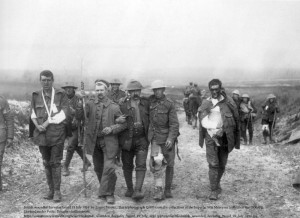 Private Tommy Atkins had just become one of the 57, 470 British casualties on the now-notorious First Day of the Somme.
Private Tommy Atkins had just become one of the 57, 470 British casualties on the now-notorious First Day of the Somme.
Shock meant that he could still feel no pain, but his training meant that his actions in the next few seconds would ultimately save his life. He tore off the pouch sewn to the inside of his uniform jacket, ripped it open and applied the contents to his wound before making his way back to the Regimental Aid Post. Tommy Atkins was lucky, not merely because the bullet had not killed him. He was lucky because this was 1916 and not 1914 and therefore the nature of his First Field Dressing meant that he had a good chance of staying alive rather than subsequently dying of sepsis caused by infection of his wound.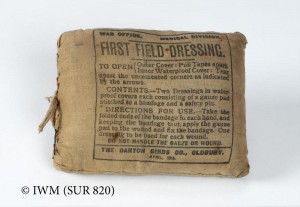
Death as a result of even relatively minor injuries due to sepsis and gas gangrene had been a major problem in late 1914 and throughout 1915 because the appalling conditions in the trenches meant that wounds were generally accompanied by fragments of dirty clothing and the bodily filth liberally and literally plastered about trench and dug-out. In 1915, however, Lt. Col. Charles Cathcart of the Royal Army Medical Corps and a Senior Surgeon at the Royal Edinburgh Infirmary, recalled that in ancient times even quite terrible wounds had been successfully dressed on the battlefield using Sphagnum bog moss. He investigated further and, on the basis of some successful trials, instigated a nationwide programme of bog-moss collection to create what would become the standard First Field Dressing issued to all UK and Imperial land forces as an integral part of their uniform. People gathered the humble bog moss across the country, from Bodmin Moor to the far north of Shetland. In Shetland, indeed, they held a ‘Shetland Sphagnum Moss Day’ on 17th August 1917 when all schools were closed and folk from across Shetland were encouraged to go out and gather the precious moss. This was to be the first of many such days held in Shetland during the remaining period of the war.
It was established that the First Field Dressing provided a number of improvements over the cotton-based dressings of the early period of the war. Sphagnum could absorb more than twice as much blood and other fluid as cotton wool and thus helped to dry out a wound so that it could heal. It was also fibrous like cotton wool and thus helped to seal the wound, but unlike cotton wool it also appeared to prevent infection of the wound in some mysterious way. Consequently Private Tommy Atkins would survive the war, albeit with a left arm which never worked entirely as it had before his injury, but at least it had not been amputated as the first stage of a slow, grisly death from gas gangrene. His First Field Dressing had somewhat miraculously prevented any infection from setting in and the astonishing efficiency of the RAMC had then ensured that 36 hours later he was back in England with his shoulder being ministered to by a team of highly-trained medical staff in a hospital south of London.
Sphagnum bog moss is a plant no larger than one’s thumb, but what it lacks in stature it makes up for in numbers.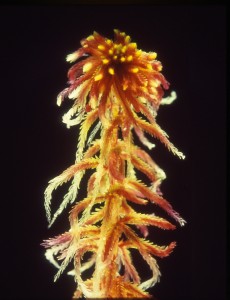 It never grows alone but rather occurs en-mass, rather like gazing down on the canopy of a rainforest from an aeroplane. It is a wetland plant, adapted both to being waterlogged and to storing water – vast quantities of it – which is the key to its absorbancy. If we look at the end of a side-branch, we see a number of leaves. Looking closely we also see that each leaf resembles, to a remarkable degree, that much-loved material bubble wrap. Except that bubble wrap cannot store water because the bubbles are sealed; once popped, all the fun goes out of bubble wrap.
It never grows alone but rather occurs en-mass, rather like gazing down on the canopy of a rainforest from an aeroplane. It is a wetland plant, adapted both to being waterlogged and to storing water – vast quantities of it – which is the key to its absorbancy. If we look at the end of a side-branch, we see a number of leaves. Looking closely we also see that each leaf resembles, to a remarkable degree, that much-loved material bubble wrap. Except that bubble wrap cannot store water because the bubbles are sealed; once popped, all the fun goes out of bubble wrap.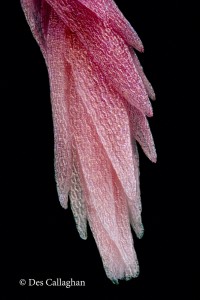 In the case of Sphagnum bog moss, however, the ‘bubbles’ are large storage cells with a number of open pores. The difficulty with such a system is that when water enters the pores the cells can expand but when water leaves the cells the whole structure simply collapses and it becomes almost impossible then to re-fill these cells – not good news for the Sphagnum plant – or for Private Tommy Atkins and the dried Sphagnum in his First Field Dressing. Fortunately for him, however, these ‘hyaline cells’ of Sphagnum have a cunning trick, in the form of spiral thickening which goes round and round the cell wall. Consequently when water exits the cell in dry conditions the cell remains a large open structure just waiting to suck in any moisture within the general vicinity.
In the case of Sphagnum bog moss, however, the ‘bubbles’ are large storage cells with a number of open pores. The difficulty with such a system is that when water enters the pores the cells can expand but when water leaves the cells the whole structure simply collapses and it becomes almost impossible then to re-fill these cells – not good news for the Sphagnum plant – or for Private Tommy Atkins and the dried Sphagnum in his First Field Dressing. Fortunately for him, however, these ‘hyaline cells’ of Sphagnum have a cunning trick, in the form of spiral thickening which goes round and round the cell wall. Consequently when water exits the cell in dry conditions the cell remains a large open structure just waiting to suck in any moisture within the general vicinity. 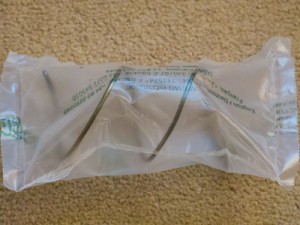 In this way it could keep the wound of Private Tommy Atkins dry and, in its natural peat bog habitat, maintain waterlogged conditions to the benefit of all its surrounding fellow Sphagnum plants.
In this way it could keep the wound of Private Tommy Atkins dry and, in its natural peat bog habitat, maintain waterlogged conditions to the benefit of all its surrounding fellow Sphagnum plants.
One other consequence of the huge size of the hyaline storage cells is that the living green photosynthetic cells of Sphagnum are tiny, squeezed into narrow strips between the relatively vast hyaline cells. Consequently there is little living tissue in the plant itself to nourish putrefying micro-organisms.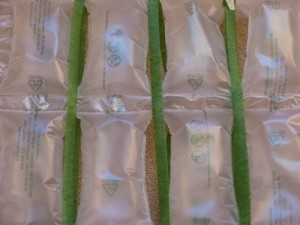 This combination of waterlogging and resulting lack of oxygen, combined with the lack of available nutrients, also means that decomposer micro-organisms are unable to keep pace with the steady, if slow, growth of a Sphagnum carpet. The partially-decayed remains of the Sphagnum bog moss therefore accumulate, perhaps only at 1 mm per year, but over a period of 10,000 years this can lead to an accumulation of Sphagnum and other plant remains which may be 10 metres deep. This waterlogged accumulation of plant material is what we know as ‘peat’. Moreover, we now know that Sphagnum has one more trick to ensure such accumulation – a trick which explains the mysterious healing power of the moss.
This combination of waterlogging and resulting lack of oxygen, combined with the lack of available nutrients, also means that decomposer micro-organisms are unable to keep pace with the steady, if slow, growth of a Sphagnum carpet. The partially-decayed remains of the Sphagnum bog moss therefore accumulate, perhaps only at 1 mm per year, but over a period of 10,000 years this can lead to an accumulation of Sphagnum and other plant remains which may be 10 metres deep. This waterlogged accumulation of plant material is what we know as ‘peat’. Moreover, we now know that Sphagnum has one more trick to ensure such accumulation – a trick which explains the mysterious healing power of the moss.
As well as depriving decomposer micro-organisms from an adequate supply of living material on which to survive, Sphagnum further starves them by exuding a chemical called ‘sphagnan’ which prevents decomposer micro-organisms from taking up nitrogen. It actively starves them. This explains why Private Tommy Atkins was able to reach the medical ministrations of a hospital back in England without any sign of sepsis or the even more feared gas gangrene having appeared. The sphagnan in his First Field Dressing had immobilized the putrefying micro-organisms.
It is no great step to go from the blood and mayhem of World War 1 to the blood and mayhem of the Vikings, but it seems that the Vikings also knew a thing or two about Sphagnum. They are reputed to have wrapped fresh salmon in Sphagnum before setting off on long voyages – a fact which has recently caught the interest of the modern food industry. Having no recipe for how the Vikings did this I thought that it would nevertheless be interesting to prepare a Viking feast for the launch of the Moors for the Future Community Science Big Moss Map Project. Having bought two bags of fresh Sphagnum from The Range, and a fresh salmon steak from Waitrose (on the assumption that this would be pretty fresh), I then cut the steak in two, slit open the two bags of Sphagnum and placed half the steak in each, wrapped both steaks tightly round with Sphagnum before sealing the bags with good old duct tape and cling-film. I then left both in the garage for a month – during a relatively sunny warm spell…
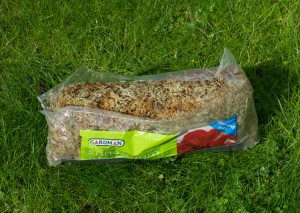 On the day before I was due to go to the Moors for the Future I opened up one bag – to see whether I had a full-scale disaster on my hands. The results were – remarkable! I took the second bag on a hot train from Colchester to Hathersage in the Peak District for the Moors for the Future Launch. At the end of my talk I offered to open the second bag (outside the hall!) for anyone who was interested – as I had no idea what we would find. Would there be a green stinking salmon soup? The result (video thanks to Debra Wilson and Joe Margetts of Moors for the Future):
On the day before I was due to go to the Moors for the Future I opened up one bag – to see whether I had a full-scale disaster on my hands. The results were – remarkable! I took the second bag on a hot train from Colchester to Hathersage in the Peak District for the Moors for the Future Launch. At the end of my talk I offered to open the second bag (outside the hall!) for anyone who was interested – as I had no idea what we would find. Would there be a green stinking salmon soup? The result (video thanks to Debra Wilson and Joe Margetts of Moors for the Future):
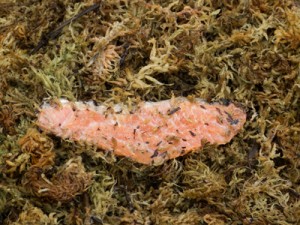 The sub-title of this piece is ‘- from WW1 to the Climate War’, so where does climate come into this? How is Sphagnum going to help us in the war on climate change? Well, it all comes back to the remarkable preservative powers of Sphagnum, as a result of which the peatlands of the world store more carbon than all the world’s vegetation combined, including the vegetation of rainforests. Many areas of rainforest, including the home of the orangutan, are first and foremost peatlands which happen to be dominated by trees rather than low-growing vegetation. The orangutan is, in effect, a peatland species, despite his nickname ‘Old Man of the Forest’. Indeed this precisely highlights the problem – the world’s peatlands are invisible – and because they are invisible we have damaged them and continue to damage them in countless ways, releasing in only decades or even just a few years the carbon which they have accumulated over millennia. Yet in terms of our opportunities to influence what happens to our global climate in the years to come, Achim Steiner, UN Under-Secretary General and Executive Director, UN Environment Programme (UNEP) has this to say:
The sub-title of this piece is ‘- from WW1 to the Climate War’, so where does climate come into this? How is Sphagnum going to help us in the war on climate change? Well, it all comes back to the remarkable preservative powers of Sphagnum, as a result of which the peatlands of the world store more carbon than all the world’s vegetation combined, including the vegetation of rainforests. Many areas of rainforest, including the home of the orangutan, are first and foremost peatlands which happen to be dominated by trees rather than low-growing vegetation. The orangutan is, in effect, a peatland species, despite his nickname ‘Old Man of the Forest’. Indeed this precisely highlights the problem – the world’s peatlands are invisible – and because they are invisible we have damaged them and continue to damage them in countless ways, releasing in only decades or even just a few years the carbon which they have accumulated over millennia. Yet in terms of our opportunities to influence what happens to our global climate in the years to come, Achim Steiner, UN Under-Secretary General and Executive Director, UN Environment Programme (UNEP) has this to say:
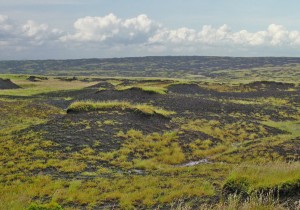 So, the 80% of our peatlands in the UK which are damaged to the point where they no longer support peat-forming vegetation, and in particular lack a Sphagnum cover, offer an enormous opportunity to prevent further carbon losses by re-establishing a peat-forming vegetation, and then to begin slowly accumulating carbon into new peatland carbon stores. Private Tommy Atkins was saved by a small pack of dried Sphagnum. Perhaps we can all be saved by the source of that Sphagnum, if we now bend our efforts to restoring peat-forming vegetation across the UK’s, and indeed the world’s, peatland ecosystems.
So, the 80% of our peatlands in the UK which are damaged to the point where they no longer support peat-forming vegetation, and in particular lack a Sphagnum cover, offer an enormous opportunity to prevent further carbon losses by re-establishing a peat-forming vegetation, and then to begin slowly accumulating carbon into new peatland carbon stores. Private Tommy Atkins was saved by a small pack of dried Sphagnum. Perhaps we can all be saved by the source of that Sphagnum, if we now bend our efforts to restoring peat-forming vegetation across the UK’s, and indeed the world’s, peatland ecosystems.
Information sources
1. Casualty numbers for the Battle of the Somme: https://en.wikipedia.org/wiki/Battle_of_the_Somme#First_day_on_the_Somme.2C_1_July
2. Role of Lt. Col. Charles Cathcart in promoting the use of Sphagnum for First Field Dressing: http://rbg-web2.rbge.org.uk/bbs/activities/field%20bryology/FB110/FB110_Ayres_Sphagnum.pdf
3. Shetland Sphagnum Moss Day: Sinclair, D.M. (2014) The gathering of Sphagnum Moss. Shetland Life, November, pp. 34-35.
4. Global peatland carbon store: Scharlemann, J.P.W., Tanner, E.V.J., Hiederer, R. & Kapos, V. (2014) Global soil
carbon: understanding and managing the largest terrestrial carbon pool. Carbon Management, 5:1, 81-91



This is so amazing? can the spagthing really preserve food, I want to know more please
Yes Naheed, the spagthing really can preserve food (and lots of other things too)! It tends to dissolve bone and other calcium-rich stuff, but human bog bodies more than 2000 years old have had modern autopsies carried out on them because the organs are so well preserved. See, for example, Tollund Man from Denmark. ‘Bog butter’ is another thing sometimes found in bogs – butter placed there 2000 or 3000 years ago to turn into a kind of buttery cheese (see, for example, modern production of bog butter). Much of what we know about Britain’s/northern Europe’s landscape & vegetation history from the times before we have written records has been obtained from peat bogs because the pollen grains from the surrounding vegetation, plus occasionally animals (and sometimes people), have all been preserved by the special conditions which exist in a peat bog – and particularly because of Sphagnum.
This is amazing and a great good news to climate change and natural food preservations
Many thanks, Dennis! And you are now helping to advance this whole story further…. 🙂